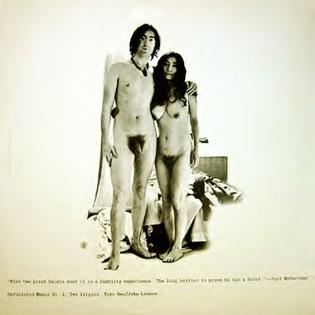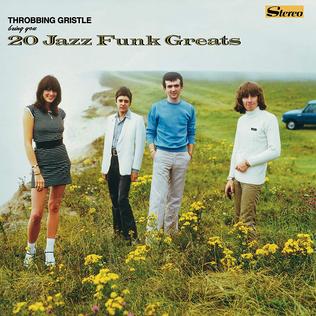Related Research Articles
Electronic music is a genre of music that employs electronic musical instruments, digital instruments, or circuitry-based music technology in its creation. It includes both music made using electronic and electromechanical means. Pure electronic instruments depended entirely on circuitry-based sound generation, for instance using devices such as an electronic oscillator, theremin, or synthesizer. Electromechanical instruments can have mechanical parts such as strings, hammers, and electric elements including magnetic pickups, power amplifiers and loudspeakers. Such electromechanical devices include the telharmonium, Hammond organ, electric piano and the electric guitar.
Psychedelic rock is a rock music genre that is inspired, influenced, or representative of psychedelic culture, which is centered on perception-altering hallucinogenic drugs. The music incorporated new electronic sound effects and recording techniques, extended instrumental solos, and improvisation. Many psychedelic groups differ in style, and the label is often applied spuriously.
Noise music is a genre of music that is characterised by the expressive use of noise within a musical context. This type of music tends to challenge the distinction that is made in conventional musical practices between musical and non-musical sound. Noise music includes a wide range of musical styles and sound-based creative practices that feature noise as a primary aspect.
Electronica is both a broad group of electronic-based music styles intended for listening rather than strictly for dancing and a music scene that started in the early 1990s in the United Kingdom. In the United States, the term is mostly used to refer to electronic music generally.
Synth-pop is a subgenre of new wave music that first became prominent in the late 1970s and features the synthesizer as the dominant musical instrument. It was prefigured in the 1960s and early 1970s by the use of synthesizers in progressive rock, electronic, art rock, disco, and particularly the Krautrock of bands like Kraftwerk. It arose as a distinct genre in Japan and the United Kingdom in the post-punk era as part of the new wave movement of the late 1970s to the mid-1980s.
Electronic body music is a genre of electronic music that combines elements of industrial music and synth-punk with elements of disco and dance music. It developed in the early 1980s in Western Europe as an outgrowth of both punk and industrial music cultures. It combines sequenced repetitive basslines, programmed dance music rhythms, and mostly undistorted vocals and commandlike shouts with confrontational or provocative themes.
Goa trance is an electronic dance music style that originated in the early 1990s in the Indian state of Goa. Goa trance often has drone-like basslines, similar to the techno minimalism of 21st century psychedelic trance (psytrance). Psychedelic trance developed from Goa trance.

Acid jazz is a music genre that combines elements of funk, soul, and hip hop, as well as jazz and disco. Acid jazz originated in clubs in London during the 1980s with the rare groove movement and spread to the United States, Japan, Eastern Europe, and Brazil. Acts included The Brand New Heavies, D'Influence, Incognito, Us3, and Jamiroquai from the UK and Buckshot LeFonque and Digable Planets from the U.S. The rise of electronic club music in the middle to late 1990s led to a decline in interest, and in the twenty-first century, the movement became indistinct as a genre. Many acts that might have been defined as acid jazz are seen as jazz-funk, neo soul, or jazz rap.
Krautrock is a broad genre of experimental rock that developed in West Germany in the late 1960s and early 1970s. It originated among artists who blended elements of psychedelic rock, avant-garde composition, and electronic music, among other eclectic sources. Common elements included hypnotic rhythms, extended improvisation, musique concrète techniques, and early synthesizers, while the music generally moved away from the rhythm & blues roots and song structure found in traditional Anglo-American rock music. Prominent groups associated with the krautrock label included Neu!, Can, Faust, Tangerine Dream, Kraftwerk, Cluster, Ash Ra Tempel, Popol Vuh, Amon Düül II and Harmonia.

Radio-Activity is the fifth studio album by German electronic music band Kraftwerk, released in October 1975. The band's first entirely electronic album is also a concept album organized around the themes of radioactive decay and radio communication. All releases of the album were bilingual, with lyrics in both English and German. The album was accompanied by single release of the title track, which was successful in France and Belgium.
Sludge metal is an extreme subgenre of heavy metal music that originated through combining elements of doom metal and hardcore punk. It is typically harsh and abrasive, often featuring shouted vocals, heavily distorted instruments and sharply contrasting tempos. The Melvins from the US state of Washington produced the first sludge metal albums in the mid-late 1980s.

Unfinished Music No. 1: Two Virgins is the first of three experimental albums released by John Lennon and Yoko Ono on Apple Records. It was the result of an all-night session of musical experimentation with Yoko in John's home studio at Kenwood, while his wife, Cynthia Lennon, was on holiday in Greece. Lennon and Ono's 1968 debut recording is known not only for its avant-garde content, but also for its cover, which features the couple naked. This made the album controversial to both the public and the parent record company EMI, which refused to distribute it. In an attempt to avoid controversy, the LP record was sold in a brown paper bag, and distributed by Track and Tetragrammaton in the United Kingdom and the United States respectively. Two Virgins, while failing to chart in the UK, reached number 124 in the US. The album was followed six months later by Unfinished Music No. 2: Life with the Lions.

Electronic Sound is the second studio album by English rock musician George Harrison. Released in May 1969, it was the last of two LPs issued on the Beatles' short-lived Zapple record label, a subsidiary of Apple Records that specialised in the avant-garde. The album is an experimental work comprising two lengthy pieces performed on a Moog 3-series synthesizer. It was one of the first electronic music albums by a rock musician, made at a time when the Moog was usually played by dedicated exponents of the technology. Harrison subsequently introduced the Moog to the Beatles' sound, and the band featured synthesizer for the first time on their 1969 album Abbey Road.
Bruce Clinton Haacklisten (help·info) was a Canadian musician and composer in the field of electronic music.

Jazz-funk is a subgenre of jazz music characterized by a strong back beat (groove), electrified sounds, and an early prevalence of analog synthesizers. The integration of funk, soul, and R&B music and styles into jazz resulted in the creation of a genre whose spectrum is quite wide and ranges from strong jazz improvisation to soul, funk or disco with jazz arrangements, jazz riffs, jazz solos, and sometimes soul vocals.
Lars-Gunnar Bodin was a Swedish pioneer in the field of electronic music during the 1960s, especially in the Scandinavian scene.

20 Jazz Funk Greats is the third studio album by British industrial music group Throbbing Gristle, released in December 1979 by the band's label Industrial Records. It is known for its tongue-in-cheek title and artwork, and has been hailed as the band's best work, with UK magazine Fact naming it the best album of the 1970s, and Pitchfork naming it the best industrial album of all time.
Cold wave is a loosely defined music genre that emerged in Europe in the late 1970s, characterized by its detached lyrical tone, use of early electronic music instruments and a minimalist approach and style. It emerged from punk rock bands who, influenced by early electronic groups such as Kraftwerk, made use of affordable portable synthesizers such as the Korg MS-20. The term can also refer to music otherwise described as "dark wave", "goth", "deathrock", "minimal wave" or "minimal synth".

The Electric Lucifer is an album by Bruce Haack combining acid rock and electronic sounds. AllMusic describes it as "a psychedelic, anti-war song cycle about the battle between heaven and hell." Haack used a Moog synthesizer and his own home-built electronics, including an early prototype vocoder. It was originally released on LP in 1970 and has been re-mastered and re-released on CD several times. The 2007 Omni Records CD release included a radio interview from 1970 and an alternate version of "Electric to Me Turn" as a bonus track. "Song of the Death Machine" and "Word Game" both feature vocals by Chris Kachulis. The lyrics mention concepts such as "powerlove" — a force so strong and good that it will not only save mankind but Lucifer himself.
Experimental pop is pop music that cannot be categorized within traditional musical boundaries or which attempts to push elements of existing popular forms into new areas. It may incorporate experimental techniques such as musique concrète, aleatoric music, or eclecticism into pop contexts. Often, the compositional process involves the use of electronic production effects to manipulate sounds and arrangements, and the composer may draw the listener's attention specifically with both timbre and tonality, though not always simultaneously.
References
- ↑ Bogdanov, Vladimir (2001). All Music Guide to Electronica: The Definitive Guide to Electronic Music . Backbeat Books. pp. 229. ISBN 978-0879306281.
Chris Kachulis.
- ↑ Brend, Mark (2012). The Sound of Tomorrow: How Electronic Music Was Smuggled into the Mainstream. Bloomsbury Academic. pp. 1953–1954, 1968. ISBN 978-0826424525.